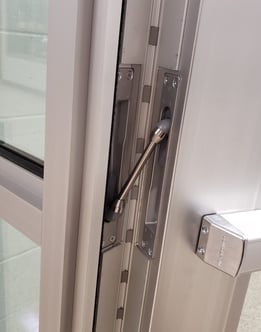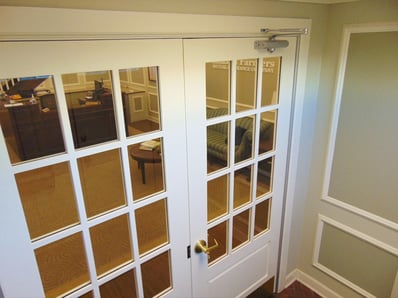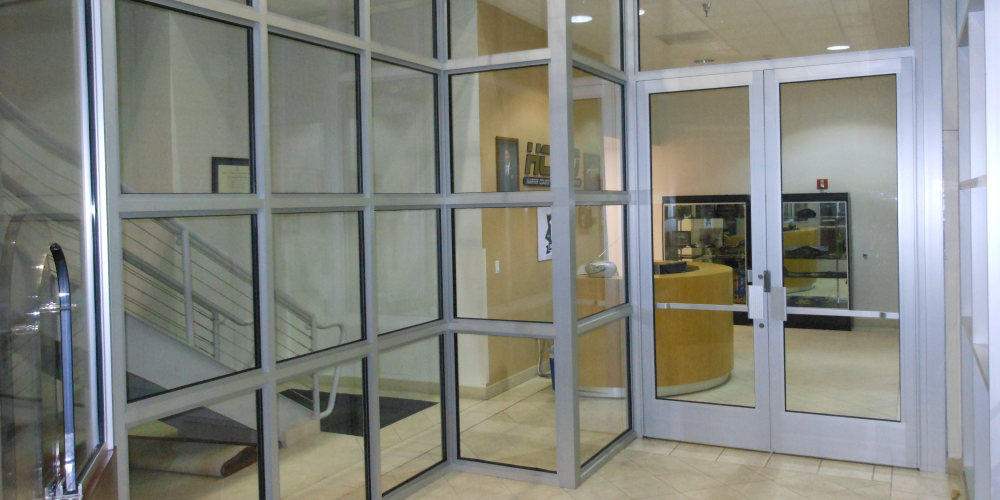People preparing bullet-resistant door specifications sometimes ask about bullet-resistant door lock hardware.
That's the wrong question. In reality, bullets don’t pose much of a threat to door locks. When doors are breached via firearm, it's by using a shotgun to blast material from the door where it anchors to the lock's latch or door's hinges. Bullet-proofing companies plan for this by minimizing the amount of material removed to accommodate locking mechanisms and other door hardware.
But that isn’t to say that there aren’t important hardware considerations when preparing a bullet-resistant door specification. Jeremy Grunn is the Engineering Manager at Total Security Solutions. He has a great deal of door and door hardware experience and often sees people struggle with door specifications for security projects.
“This can even apply to something very basic, like the lockset and the strike plate. If you have a cylindrical lock set, you want to make sure that it can engage with the strike that you spec. Because if the strike doesn’t accept the latch, the door won’t be able to stay closed. But it can also be much less obvious, like specifying a hinge that will work well for a few months, but ultimately fail under the weight and strain.”
How is Ballistic Door Hardware Different from “Normal” Door Hardware?
If there's no such thing as "bulletproof" door hardware, then what are the real differences between "normal" door hardware and the hardware you need for a bulletproof door?
Generally, it comes back to the dimensions and durability.
Bullet-resistant doors are often thicker, and always heavier, than their non-ballistic equivalents. Therefore, you'll need hinges that can bear more weight and locking mechanisms that can accommodate the added door thickness. Off-the-shelf door locksets are made for standard doors, which tend to be between 1-3/8 and 1-3/4-inch thick. While some bulletproof doors are just 1-1/4 inch thick, many are closer to 2-1.2 inches thick. Ballistic doors for government facilities may be nearly four inches thick and four to five times heavier than a standard commercial door.
Do the Continued Supply Chain Difficulties Mean I Have to Plan My Ballistic Door Differently?
In general, supply chain issues and the volatile economy continue to create havoc for builders. This is especially the case with niche products like ballistic barriers and their components. For example, many builders report door hardware lead times of 3 to 6 months (or longer). Fortunately, early in the pandemic, TSS took steps to diversify their supply chains and insulate their customers from this volatility.
What Should I Think About When Considering Hardware for Bullet-Resistant Doors?
There are four hardware elements to consider in your bullet-resistant door specifications:
Locks and Strikes
In most cases, you can spec whatever style of lock and strike you prefer. If the door exceeds the maximum thickness that commercial extension kits can accommodate, experienced bulletproof companies like TSS can find an adaptation to make it all work together smoothly.
If you need an electric "buzz through" strike, TSS advises going with a HES-5000 in most cases. (There are similar HES strikes for other styles of doors, such as those with panic bars).

Hinges
Given the weight of ballistic doors, you need a continuous hinge for long-term operability and durability. This also has the added bonus of being much harder to breach by force.
TSS favors a continuous geared hinge because it offers the best long-term value. That said, TSS can design a door to use a continuous pin-and-barrel hinge instead if that's preferred.
Closer/Auto-Closers/Openers
TSS recommends LSDA surface-mounted door closers. These adjustable closers are already standard in many non-ballistic commercial applications. They've proven quite adept at handling the added weight of a ballistic door, making them easier to operate on a daily basis. According to Jeremy Grunn, "you can adjust them so a little old person can open a 400-pound door with ease."
LSDA closers are available in several models, including concealed closers. While the surface mount is the standard solution, TSS often installs LSDA concealed models, notching them into ballistic doors.

TSS suggests "light-duty" LSDA closers for Level 1 and 2 doors and heavy-duty closers for doors rated at UL Level 3 and above. When accessibility or ADA compliance are issues, TSS can help you select an appropriate push-button surface-mounted auto-opener that will be able to handle the added weight of a ballistic door.
Auto-closers (like those seen in grocery stores) are usually not recommended for ballistic doors. The motors and gearing for most auto-closer models on the market today simply are not designed to handle the weight of a ballistic door.
Push Bar/Panic Bar
Push bars can get a little tricky. This is especially the case with "store-front"-type ballistic doors, as the width of the door's aluminum stiles affect what types and styles of push bar you can use.
But even on solid doors, a push bar presents challenges, as it necessarily interacts with all of the door's systems (e.g., closers, auto-openers, dummy or electric strikes, etc.)
Expert Advice for Optimal Functionality
“The most important thing," Jeremy concludes, "is to understand how the door is going to function. How is it going to open? How is it going to lock? Do people need to be buzzed in? Do you need wire run through the frames or through the doors? Do you need a panic bar? If we can answer those questions, then we can dig into details: Does it need to be electrified? Are you going to need to scan a card to get in? If you’ve established the basics, we’ll make sure the hardware spec will work together. If it doesn’t, we’ll have suggestions.”
On every job, TSS draws from their extensive experience with custom ballistic doors and a team adept at creating entirely new solutions for an evolving threat landscape. You can contact our ballistic security experts today to discuss a project that's on the horizon or get help solving a specific security problem right now.

